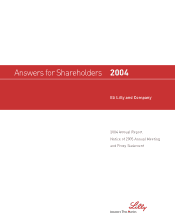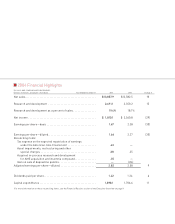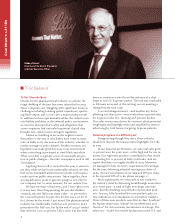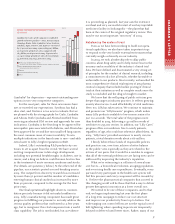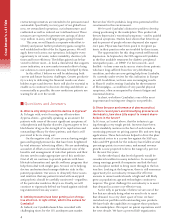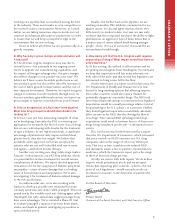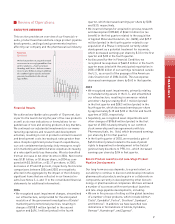Eli Lilly 2004 Annual Report Download - page 4
Download and view the complete annual report
Please find page 4 of the 2004 Eli Lilly annual report below. You can navigate through the pages in the report by either clicking on the pages listed below, or by using the keyword search tool below to find specific information within the annual report.
2
CHAIRMAN’S LETTER
Sidney Taurel
Chairman of the Board, President,
and Chief Executive Offi cer
“Fair Balance”
To Our Shareholders
Clearly, for the pharmaceutical industry as a whole, the
tough sledding of the past few years intensifi ed in 2004.
Many companies are struggling with signifi cant business
challenges including looming patent expirations, sputter-
ing R&D output, and, in one case, a major product recall.
In addition to these operational troubles, the industry ran
into further problems in the external policy environment,
as concerns about product safety and allegations that
some companies had concealed important clinical data
brought new calls for more stringent regulation.
Almost as troubling to me as the negative events
themselves is the way in which they have come to domi-
nate virtually every discussion of the industry, whether in
media coverage or policy debates. Neither investors nor
legislators can make good decisions in an environment
where everything is portrayed in stark black and white.
What is needed is a greater sense of reasonable propor-
tion in public dialogue—the ethic newspapers used to call
“fair balance.”
Applying this to Lilly’s record for the year, it seems to
me that, while we had some undeniable setbacks, we also
had some remarkable achievements in both our business
results and our public interactions. Taken together, these
accomplishments point to genuine progress not only for
our company, but, in some measure, for our industry too.
We had our share of bad news, and I won’t gloss over
it in any way. Most disappointing for our shareholders,
certainly, was the fall in our share value—19 percent for
the 12-month period. In part, this decline was a sector ef-
fect, driven by the events I just noted. The pharmaceutical
industry has traditionally traded at a 20 percent or more
premium to the S&P 500, but by the end of 2004 it trailed
that index by 15 to 20 percent. Lilly’s stock was also held
down as investors waited to see the outcome of a chal-
lenge to our U.S. Zyprexa® patent. The trial was concluded
in February 2004 and, at this writing, we are awaiting a
ruling from the trial court.
A second disappointment—and another key factor
affecting our share price—was weaker-than-expected sales
for Zyprexa in the U.S., showing an 8 percent decline.
This sales erosion was driven by concerns about potential
weight gain and hyperglycemia and amplifi ed by intense
advertising by trial lawyers targeting Zyprexa patients.
Genuine progress in a diffi cult year
Disappointing though they were, these setbacks
should not obscure the many positive highlights for Lilly
in 2004.
In our fi nancial performance, we saw total sales grow
10 percent over the prior year—at the high end for our in-
dustry. Our eight new products contributed to that result,
accounting for 11 percent of Lilly’s total sales. And we
expect that share to roughly double in 2005. Moreover,
we managed to beat investors’ expectations for earnings
for the year, delivering adjusted earnings per share of
$2.82. (For a reconciliation of our adjusted EPS per share
to the reported EPS of $1.66, please see page 1.)
Most signifi cantly, we continued to run counter to
the industry trend by delivering breakthrough innovation
at a record pace—a total of eight new drugs since late
2001, thereby doubling our portfolio of promoted prod-
ucts. In 2004, Lilly launched fi ve new products plus six
new indications or formulations in several key markets.
Three of these new products were fi rst-in-class: Symbyax™
for bipolar depression, Alimta® for mesothelioma, and
Yentreve® for stress urinary incontinence in Europe. The
other two—Cialis® for erectile dysfunction in the U.S. and

